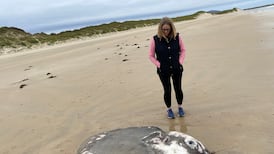Moves that could lead to a merger between Labour and Democratic Left are under way following an exploratory meeting between the two party leaders, Mr Ruairi Quinn and Mr Proinsias De Rossa.
The process of developing "a new political formation" between the parties took a significant step forward on Saturday when Democratic Left's 40-strong national executive committee almost unanimously agreed a motion clearing the way to enter discussions with Labour as part of an initiative to strengthen the left in Ireland.
The motion was tabled by the party's four TDs, including Mr De Rossa who has long been regarded as an opponent of a merger. After an hour-long discussion yesterday Mr De Rossa, who requested the meeting, and Mr Quinn said the endorsement of the Belfast Agreement could alter profoundly the nature of politics in the Republic.
While their two parties had divergent traditions, they also shared common goals. The leaders will now consult their parties on developments towards closer unity.
The Labour leader will report to his parliamentary party tomorrow and to the party's general council and executive committee on Thursday. "The Labour Party will enter into discussions with Democratic Left in a spirit of goodwill and openness and we will work constructively to develop a left strong enough to take on the two traditional parties," Mr Quinn said.
Denying that the development was the first step towards a merger, the Democratic Left leader said he would not "rule anything in or out" regarding union between the two parties. This was "but the first step in creating a bigger left in Ireland", he added.
"We need to grow the left. I hope we create an excitement about left politics. Those who are tired of the traditional nationalist-driven politics of Fianna Fail and Fine Gael will look to an alternative formation on the left," he said.
There was an opportunity to "join forces with our sister party to pursue a new left agenda for the coming decades". This would not be achieved by one party swallowing the other but through a partnership and "the pooling of the physical and intellectual resources of both which would acknowledge the broad similarity of our objectives and respect the diversity of our traditions".
It was a question of how the parties could advance a programme which enabled people to give them the numbers to be a dominant group in government or to form a left government on their own. To achieve this, the left would have to translate policies, structures and strategies into firm electoral support, Mr De Rossa added.
Sources in both parties said there were three possible outcomes to the discussion process: a merger; a "common platform" in the Dail and at election time; or a new party. But Labour sources were sceptical of the possibility of a new party, saying its members would be most reluctant to rename the party, in existence since 1912.
Democratic Left's Dail representation was cut from six to four in the 1997 general election while Labour's fell from 32 to 17. Victory in the Dublin North by-election left them with 18 Dail seats, including the Ceann Comhairle.
The combined left vote in the general election was less than 13 per cent and the left vote in Ireland has never exceeded 22 per cent; statistics which should force a rethink within the parties, according to Democratic Left.









